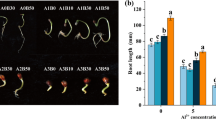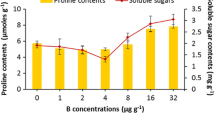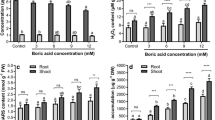Abstract
It has been reported that aluminum (Al) toxicity is a major limiting factor for plant growth and production on acidic soils. Boron (B) is indispensable micronutrient for normal growth of higher plants, and its addition could alleviate Al toxicity. The rape seedlings were grown under three B (0.25, 25 and 500 μM) and two Al concentrations [0 (−Al) and 100 μM (+Al) as AlCl3·6H2O]. The results indicated that Al stress severely hampered root elongation and root activity at 0.25 μM B while the normal (25 μM) and excess (500 μM) B improved the biomass of rape seedlings under Al exposure. Additionally, normal and excess B treatment reduced accumulation of Al in the roots and leaves under Al toxicity, which was also confirmed by hematoxylin with light staining. This indicates that both normal and excess B could alleviate Al toxicity. Furthermore, it also decreased the contents of malondialdehyde and soluble protein under Al toxicity. Likewise, superoxide dismutase activity (SOD) improved by 97.82 and 131.96% in the roots, and 168 and 119.88% in the leaves at 25 and 500 µM B, respectively, while the peroxidase and catalase activities dropped as a result of Al stress. The study results demonstrated that appropriate B application is necessary to avoid the harmful consequences of Al toxicity in rape seedlings.






Similar content being viewed by others
References
Achary VM, Jena S, Panda KK, Panda BB (2008) Aluminium-induced oxidative stress and DNA damage in root cells of Allium cepa L. Ecotoxicol Environ Saf 70:300–310
Aebi H (1983) Catalase. In: Bergmeyer HU (ed) Methods of enzymatic analyses verlag nodulation of neuronal excitability by NO. Trends Neurosci 25:510–517
Ashraf M, Foolad M (2007) Roles of glycine betaine and proline in improving plant abiotic stress resistance. Environ Exp Bot 59:206–216
Bai B, Jin J, Huang L, Bai S (1994) Improvement of TTC method determining root activity in corn. Maizeence 4:44–47 (in Chinese with English abstract)
Beauchamp C, Fridovich I (1971) Superoxide dismutase: improved assays and an assay applicable to acrylamide gels. Anal Biochem 44:276–287
Blamey F, Edwards D, Asher C (1983) Effects of aluminum, OH:Al and P:Al molar ratios, and ionic strength on soybean root elongation in solution culture. Soil Sci 136:197–207
Blevins DG, Lukaszewski KM (1998) Boron in plant structure and function. Annu Rev Plant Physiol Plant Mol Biol 49:481–500
Brown PH, Hu H (1997) Does boron play only a structural role in the growing tissues of higher plants? Plant Soil 196:211–215
Brown PH, Bellaloui N, Wimmer MA, Bassil ES, Ruiz J, Hu H, Pfeffer H, Dannel F, Roemheld V (2002) Boron in plant biology. Plant Biology 4:205–223
Cai K, Gao D, Luo S, Zeng R, Yang J, Zhu X (2008) Physiological and cytological mechanisms of silicon-induced resistance in rice against blast disease. Physiol Plant 134:324–333
Chang Y, Yamamoto Y, Matsumoto H (1999) Accumulation of aluminium in the cell wall pectin in cultured tobacco (Nicotiana tabacum L.) cells treated with a combination of aluminium and iron. Plant Cell Environ 22:1009–1017
Chen Q, Chen L, Wu K, Li K, Yu Y (2012) Research progresses in plant aluminum-responsive genes. J Plant Genet Resour 13:858–864
Corrales I, Poschenrieder C, Barceló J (2008) Boron-induced amelioration of aluminum toxicity in a monocot and a dicot species. J Plant Physiol 165:504–513
Delhaize E, Ryan PR (1995) Aluminum toxicity and tolerance in plants. Plant Physiol 107:315–321
Dible W, Truog E, Berger K (1954) Boron determination in soils and plants. Anal Chem 26:186–196
Dong B, Sang W, Jiang X, Zhou J, Kong F, Hu W, Wang L (2002) Effects of aluminum on physiological metabolism and antioxidant system of wheat (Triticum aestivum L). Chemosphere 47:87–92
Franco CR, Chagas AP, Jorge RA (2002) Ion-exchange equilibria with aluminum pectinates. Colloids Surf A 204:183–192
Goldbach HE, Huang L, Wimmer MA (2007) Boron functions in plants and animals: recent advances in boron research and open questions, Advances in plant and animal boron nutrition. Springer, Amsterdam, pp 3–25
Goldberg S (1997) Reactions of boron with soils. Plant Soil 193:35–48
Gunes A, Alpaslan M, Cikili Y, Ozcan H (1999) Effect of zinc on the alleviation of boron toxicity in tomato. J Plant Nutr 22:1061–1068
Guo T, Zhang G, Zhou M, Wu F, Chen J (2004) Effects of aluminum and cadmium toxicity on growth and antioxidant enzyme activities of two barley genotypes with different Al resistance. Plant Soil 258:241–248
Guo T, Chen Y, Zhang Y, Jin Y (2006) Alleviation of Al toxicity in barley by addition of calcium. Agric Sci China 5:828–833
Heidarabadi MD, Ghanati F, Fujiwara T (2011) Interaction between boron and aluminum and their effects on phenolic metabolism of Linum usitatissimum L. roots. Plant Physiol Biochem 49:1377–1383
Horst WJ, Wang Y, Eticha D (2010) The role of the root apoplast in aluminium-induced inhibition of root elongation and in aluminium resistance of plants: a review. Ann Bot 106:185–197
Hu H, Brown PH, Labavitch JM (1996) Species variability in boron requirement is correlated with cell wall pectin. J Exp Bot 47:227–232
Huang X, Li Y, Dong D (2009) Comparison of reactive oxygen metabolism in response to phosphorus deficiency and aluminum toxicity in two contrasting soybean genotypes. Southwest China J Agric Sci 22:615–620
Islam E, Yang X, Li T, Liu D, Jin X, Meng F (2007) Effect of Pb toxicity on root morphology, physiology and ultrastructure in the two ecotypes of Elsholtzia argyi. J Hazard Mater 147:806–816
Jiang H, Tang N, Zheng J, Chen L (2009) Antagonistic actions of boron against inhibitory effects of aluminum toxicity on growth, CO2 assimilation, ribulose-1, 5-bisphosphate carboxylase/oxygenase, and photosynthetic electron transport probed by the JIP test, of Citrus grandis seedlings. BMC Plant Biol 9:102–118
Kinraide TB (1991) Identity of the rhizotoxic aluminium species. Plant Soil 134:167–178
Kobayashi M, Nakagawa H, Asaka T, Matoh T, Kobayashi M (1999) Borate-rhamnogalacturonan II bonding reinforced by Ca2+ retains pectic polysaccharides in higher-plant cell walls. Plant Physiol 119:199–203
Lee DH, Kim YS, Lee CB (2001) The inductive responses of the antioxidant enzymes by salt stress in the rice (Oryza sativa L.). J Plant Physiol 158:737–745
Lenoble M, Blevins D, Sharp R, Cumbic B (1996) Prevention of aluminum toxicity with supplemental boron I. Maintenance of root elongation and cellular structure. Plant Cell Environ 19:1132–1142
Li M, Yu M (2013) Characteristics of adsorption and desorption of aluminum in pectin as influenced by boron. Sci Agric Sin 46:1595–1602
Li X, Liu J, Fang J, Tao L, Shen R, Li Y, Xiao H, Feng Y, Wen H, Guan J, Wu L, He Y, Goldbach H, Yu M (2017) Boron supply enhances aluminum tolerance in root border cells of pea (Pisum sativum) by interacting with cell wall pectins. Front Plant Sci 8:742
Loomis WD, Drust R (1992) Chemistry and biology of boron. Biofactors (Oxford, England) 3:229–239
Ma J, Furukawa J (2003) Recent progress in the research of external Al detoxification in higher plants: a minireview. J Inorg Biochem 97:46–51
Malekzadeh P, Mehr RS, Hatamnia AA (2015) Effects of aluminum toxicity on maize (Zea mays L.) seedlings. Iran J Plant Physiol 5:1289–1296
Manov GG, Bates RG, Hamer WJ, Acre SF (2002) Values of the constants in the Debye—Hückel equation for activity coefficients. J Am Chem Soc 86:1433–1441
Matoh T (1997) Boron in plant cell walls. Plant Soil 193:59–70
Matoh T, Kobayashi M (1998) Boron and calcium, essential inorganic constituents of pectic polysaccharides in higher plant cell walls. J Plant Res 111:179–190
Mizuno M, Kamei M, Tsuchida H (1998) Ascorbate peroxidase and catalase cooperate for protection against hydrogen peroxide generated in potato tubers during low-temperature storage. IUBMB Life 44:717–726
O’Neill MA, Ederhard S, Albersheim P, Darvill AG (2001) Requirement of borate cross-linking of cell wall rhamnogalacturonan II for Arabidopsis growth. Science 294:846–849
Polle E, Konzak CF, Kattrick JA (1978) Visual detection of aluminum tolerance levels in wheat by hematoxylin staining of seedling roots. Crop Sci 18:823–827
Poschenrieder C, Gunsé B, Corrales I, Barceló J (2008) A glance into aluminum toxicity and resistance in plants. Sci Total Environ 400:356–368
Riaz M, Yan L, Wu X, Hussain S, Aziz O, Wang Y, Imran M, Jiang C (2017) Boron alleviates the aluminum toxicity in trifoliate orange by regulating antioxidant defense system and reducing root cell injury. J Environ Manag 208:149–158
Ruiz J, Rivero R, Romero L (2006) Boron increases synthesis of glutathione in sunflower plants subjected to aluminum stress. Plant Soil 279:25–30
Ryan P, Delhaize E, Randall P (1995) Malate efflux from root apices and tolerance to aluminium are highly correlated in wheat. Funct Plant Biol 22:531–536
Tang N, Jiang H, Yang L, Li Q, Yang G, Chen L (2011) Boron-aluminum interactions affect organic acid metabolism more in leaves than in roots of Citrus grandis seedlings. Biol Plant 55:681–688
Vos C, Schat H, Waal M, Vooijs R, Ernst W (1991) Increased resistance to copper-induced damage of the root cell plasmalemma in copper tolerant Silene cucubalus. Physiol Plant 82:523–528
Wang F (1989) Theoretical single-ion activity coefficients in aqueous. J East China Inst Technol 51:46–52 (in Chinese with English abstract)
Wang Z, Liu P (2013) Effect of citric acid inhibitor Mersal on antioxidant enzymes activities in oilseed rape leaves under aluminum stress. Jiangsu J Agric Sci 29:957–966 (in Chinese with English abstract)
Wang F, Liu P, Xu G, Luo L (2005) Effects of aluminium on some physiological characters of buckwheat. J Agro-Environ Sci 24:678–681
Xiao N, Tang H, Guo Q (1998) Study on sustainable development of rape production in China. Crops, pp 11–13 (in Chinese with English abstract)
Yan L, Jiang C, Muhammad R, Wu X, Lu X, Du C, Wang Y (2017) Mitigative effect of different forms of boron on aluminum toxicity of rape seedlings and its FTIR characteristics. Acta Agron Sin 43:1814–1823 (in Chinese with English abstract)
Yang Y, Zhang H (1998) Boron amelioration of aluminum toxicity in mungbean seedlings. J Plant Nutr 21:1045–1054
Yang Y, Gu H, Fan W, Bilkisu A (2004) Effects of boron on aluminum toxicity on seedlings of two soybean cultivars. Water Air Soil Pollut 154:239–248
Yu M, Shen R, Xiao H (2009) Boron alleviates aluminum toxicity in pea. Plant Soil 314:87–98
Zhang F, Xu X (2001) Mitigative effect of exogenous boron on the wheat seedlings under aluminum stress. Plant Physiol Commun 37:21–24 (in Chinese with English abstract)
Zhang L, Wu J, Mei L, Wu J (2011) Saline tolerance of camptotheca acuminata provenances and the index selection for saline tolerance. Sci Silvae Sin 47:66–72
Zhang H, Jiang Z, Wang C (2013) Effects of aluminum stress on soluble protein contents in roots and leaves of Hordeum vulgare L. Modern Agric Sci Technol 16:13–15
Acknowledgements
The present work was supported by the “National Natural Science Foundation of China (41271320)” and the “Fundamental Research Funds for the Central Universities (2017PY055)”.
Author information
Authors and Affiliations
Corresponding author
Additional information
Communicated by S. Srivastava.
Rights and permissions
About this article
Cite this article
Yan, L., Riaz, M., Wu, X. et al. Interaction of boron and aluminum on the physiological characteristics of rape (Brassica napus L.) seedlings. Acta Physiol Plant 40, 33 (2018). https://doi.org/10.1007/s11738-018-2614-y
Received:
Revised:
Accepted:
Published:
DOI: https://doi.org/10.1007/s11738-018-2614-y




